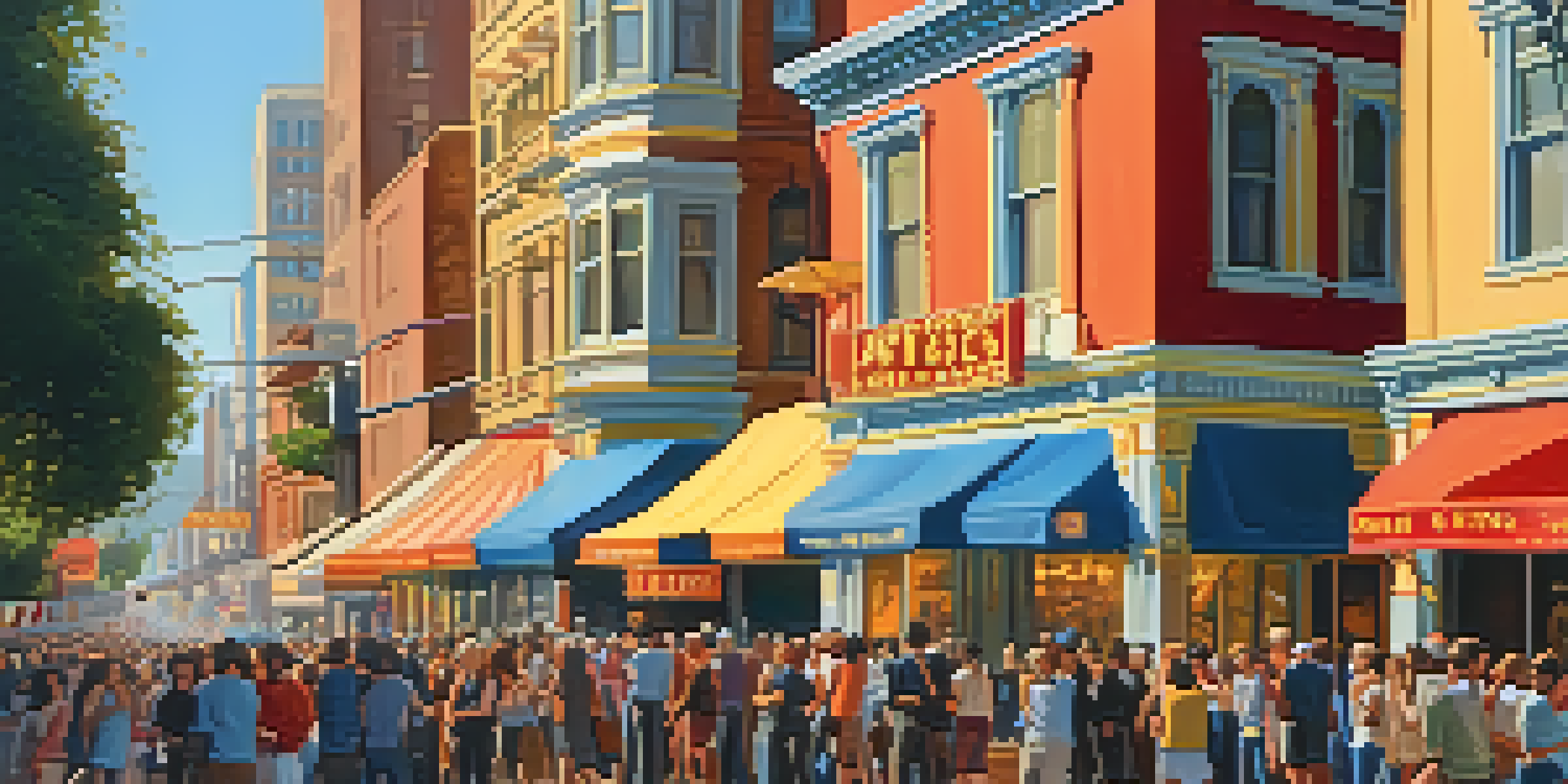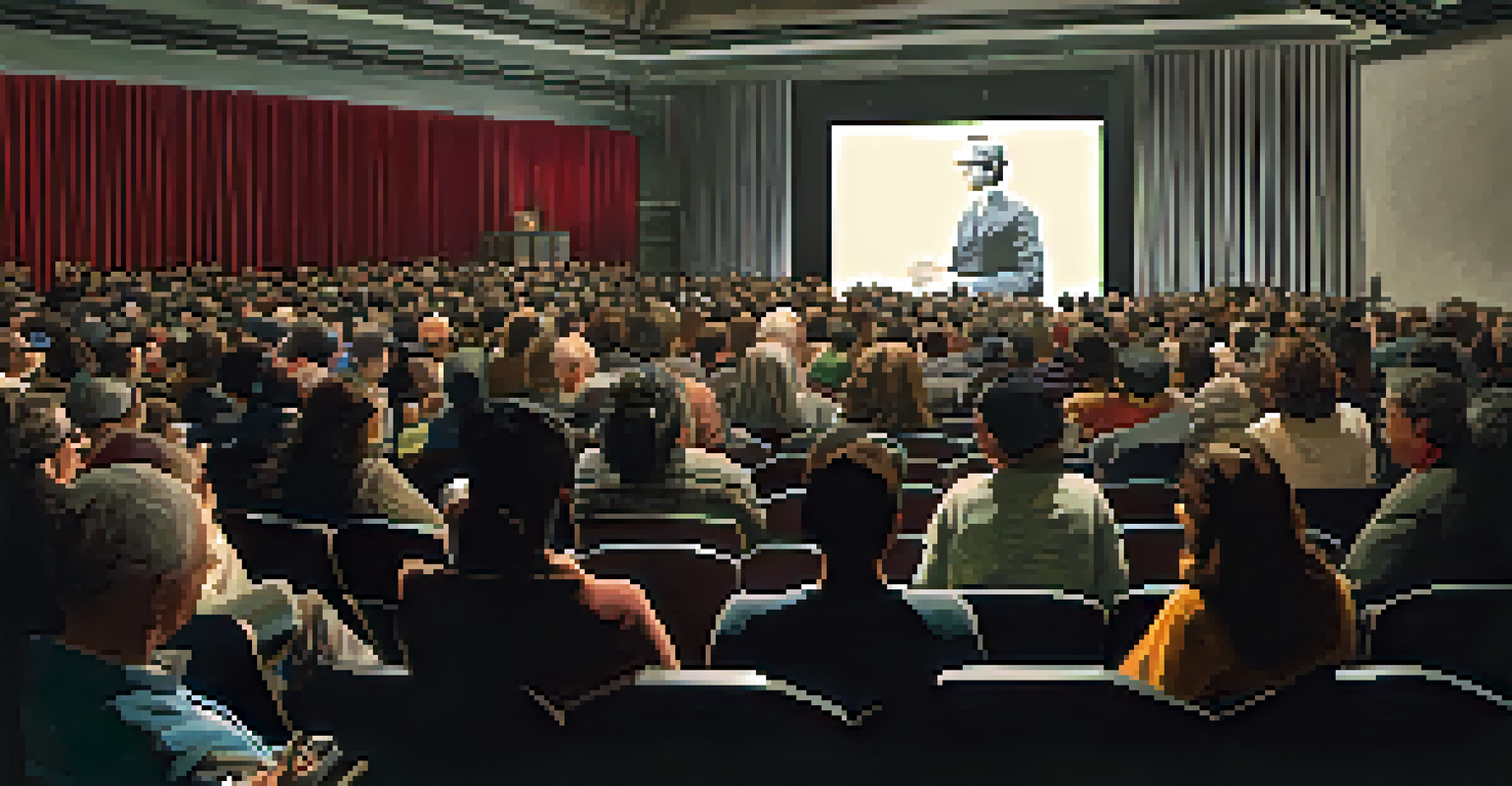Exploring the History of San Francisco's Iconic Film Festivals

The Birth of Film Festivals in San Francisco
San Francisco has long been a hub for creative expression, and its film festivals are a testament to that legacy. The city's first major festival, the San Francisco International Film Festival, was launched in 1957, making it one of the oldest in the United States. This festival set the stage for a thriving cinematic community, attracting filmmakers and audiences from around the globe.
Film is a reflection of our society, a mirror that shows us who we are and what we can become.
In those early years, the festival showcased a mix of documentaries, shorts, and features, embodying the eclectic spirit of the city. It became a platform for emerging filmmakers, allowing them to share their stories and perspectives in a supportive environment. As attendance grew, so did the festival's reputation, ultimately establishing San Francisco as a key player in the film world.
The success of the San Francisco International Film Festival paved the way for other festivals in the area. It sparked a film-loving culture that encouraged the development of niche festivals, catering to diverse audiences and genres, from LGBTQ+ themes to environmental issues.
The Rise of the San Francisco International Film Festival
The San Francisco International Film Festival (SFIFF) has become synonymous with cinematic innovation and excellence. Over the years, it has showcased groundbreaking films and fostered work from international filmmakers. This festival not only highlights established names but also champions new talent, ensuring a vibrant future for the film industry.

With its extensive lineup of features, documentaries, and shorts, SFIFF has become a must-attend event for film enthusiasts. Attendees are treated to a rich tapestry of storytelling that reflects global issues and local narratives. The festival's panels and discussions also provide insights into the craft, allowing audiences to connect with filmmakers on a deeper level.
San Francisco's Film Festival Legacy
The San Francisco International Film Festival, launched in 1957, established the city as a key player in the film community.
In addition to its impressive programming, SFIFF has embraced technology and innovation, adapting to the changing landscape of film. From virtual screenings to interactive experiences, the festival remains at the forefront of the film festival movement, continually evolving to meet the needs of its audience.
The LGBTQ+ Focus of the Frameline Festival
Frameline, the San Francisco International LGBTQ+ Film Festival, has played a pivotal role in representing LGBTQ+ voices since its inception in 1977. This festival has been a beacon of hope and representation, providing a platform for stories that often go untold. Frameline has consistently pushed boundaries, fostering a sense of community and acceptance through film.
Cinema is a matter of what's in the frame and what's out of it.
Over the years, Frameline has grown into one of the largest LGBTQ+ film festivals in the world, showcasing films that challenge stereotypes and advocate for equality. Each year, it features a diverse lineup of films, including powerful documentaries and groundbreaking narratives. This celebration of queer cinema not only entertains but also educates audiences about important social issues.
Frameline’s impact extends beyond the festival itself; it has helped launch numerous careers in the film industry. Many filmmakers credit Frameline as a crucial stepping stone, providing exposure and validation for their work. The festival has become an integral part of San Francisco's cultural fabric, reflecting the city's commitment to diversity and inclusion.
Documentary Focus: The SF DocFest
The San Francisco Documentary Film Festival, or SF DocFest, has carved out a unique niche in the film festival landscape since its launch in 2001. This festival is dedicated to showcasing compelling non-fiction storytelling, providing a space for documentary filmmakers to share their work with enthusiastic audiences. It's a celebration of real-life narratives that can inspire and provoke thought.
SF DocFest has gained recognition for its diverse programming, featuring everything from social justice issues to personal stories. This variety allows audiences to engage with a wide range of subjects, sparking conversations that can lead to deeper understanding and empathy. The intimate settings of the screenings also encourage meaningful discussions after each film.
Diversity in Film Festivals
Film festivals like Frameline and CAAMFest highlight underrepresented voices, promoting inclusivity and cultural understanding.
In addition to its regular programming, SF DocFest often includes workshops and panels that provide filmmakers with valuable insights and feedback. This dedication to education and community-building makes it a significant event for both filmmakers and documentary enthusiasts alike, solidifying its place in the San Francisco film festival scene.
Cinematic Diversity at the CAAMFest
The Center for Asian American Media Festival, known as CAAMFest, celebrates Asian and Asian American voices in film. Since its founding in 1983, the festival has highlighted the rich tapestry of stories from Asian communities, fostering understanding and representation. This focus on diversity has made CAAMFest a vital part of San Francisco's cultural landscape.
CAAMFest showcases a wide array of films, from feature-length narratives to shorts and documentaries. Each year, it presents groundbreaking works that challenge stereotypes and offer fresh perspectives on the Asian American experience. The festival not only provides a platform for filmmakers but also engages audiences in important dialogues about identity and culture.
Moreover, CAAMFest serves as a hub for networking and collaboration, bringing together filmmakers, artists, and audiences. The festival's commitment to nurturing talent has led to the emergence of numerous influential voices in cinema. As it continues to grow, CAAMFest remains a significant force for cultural representation and exploration in San Francisco.
The Role of Technology in Film Festivals
As technology evolves, so too do film festivals in San Francisco. The integration of digital platforms and streaming services has transformed the way audiences experience films. This shift has allowed festivals to reach broader audiences, breaking geographical barriers that once limited attendance.
For instance, many festivals now offer hybrid formats, combining in-person screenings with online access. This flexibility has not only increased accessibility but also allowed filmmakers to showcase their work to a global audience. It’s a game-changer that has encouraged innovation and experimentation in storytelling.
Technology's Impact on Festivals
The integration of digital platforms has transformed film festivals, allowing broader access while maintaining the essence of in-person experiences.
While the digital experience is invaluable, many attendees still cherish the in-person connections that festivals offer. The excitement of watching a film with a live audience and engaging in discussions with filmmakers creates a unique atmosphere that can't be replicated online. As festivals continue to adapt, they strive to maintain this balance between tradition and modernity.
Looking Ahead: The Future of San Francisco Film Festivals
The future of San Francisco's film festivals looks bright as they continue to evolve with changing times. With an increasing emphasis on diversity and representation, festivals are set to showcase even more varied voices and stories. This commitment to inclusivity will enrich the cinematic landscape and foster a deeper understanding of different cultures.
Moreover, as the film industry embraces new technologies, festivals will likely explore innovative formats and experiences. From virtual reality to interactive screenings, the potential for creativity is endless. These advancements promise to engage audiences in exciting new ways, making film festivals more dynamic and accessible than ever before.

Ultimately, the spirit of San Francisco's film festivals will remain rooted in community and connection. As filmmakers, audiences, and industry professionals come together to celebrate the art of storytelling, these festivals will continue to play a crucial role in shaping the future of cinema. The journey ahead is sure to be as vibrant and transformative as the rich history that precedes it.